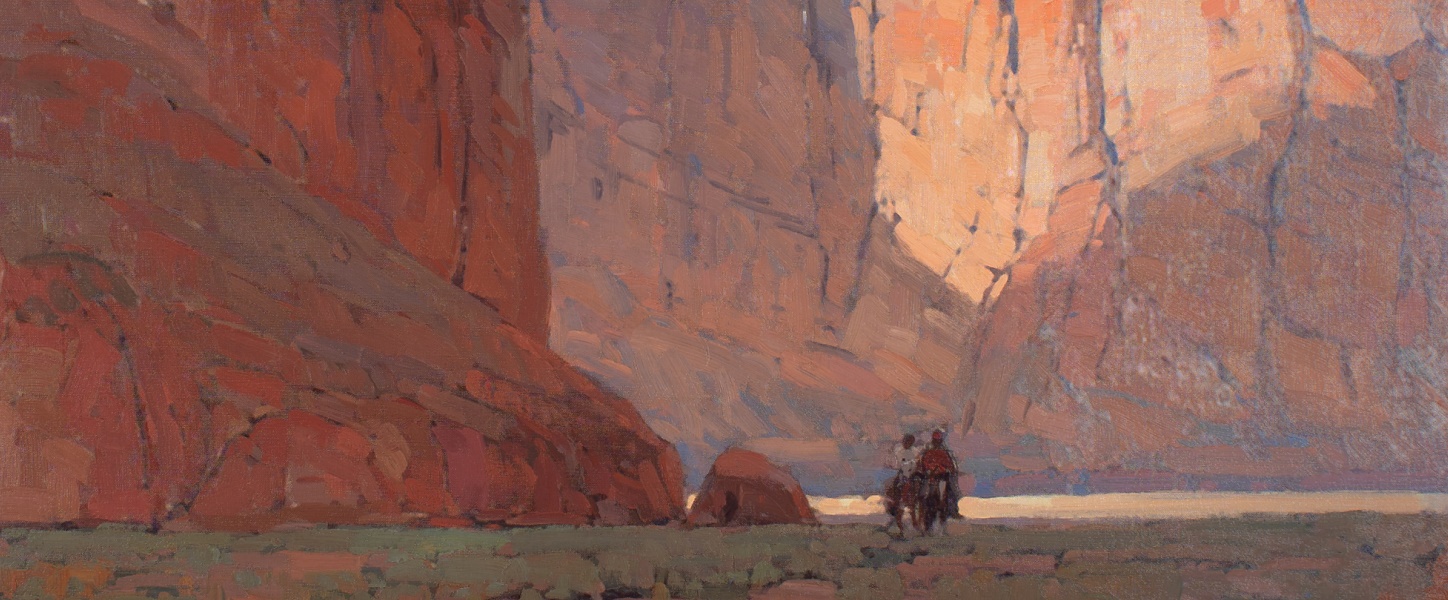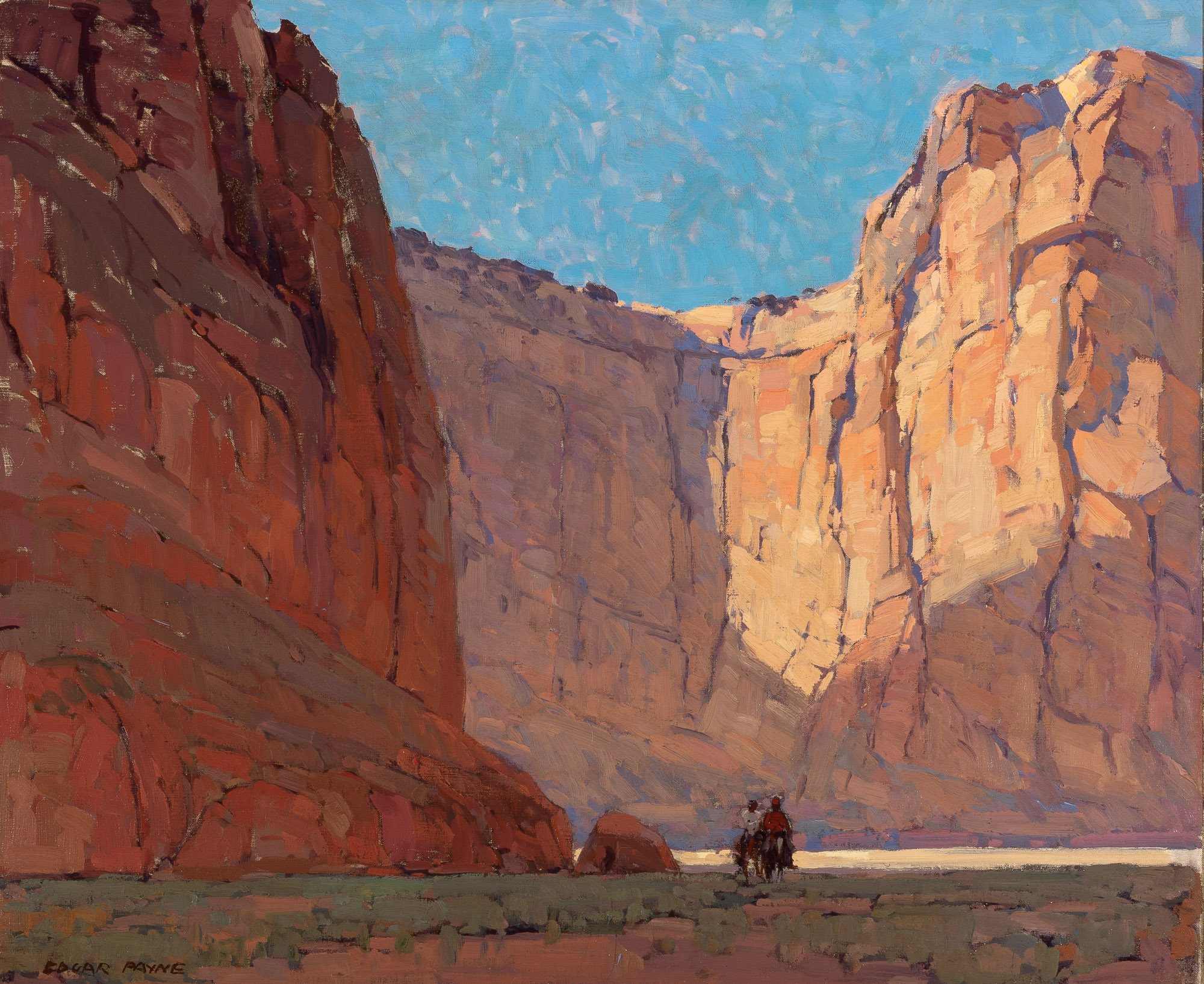

05/08/2024 General, General Paintings, American Art
Edgar Payne, the oldest son of eight children, was born in 1883. His formal schooling was short-lived, ending with the fifth grade when the family relocated from Missouri to Arkansas. He left home at 14, finding work painting houses and signs. Although largely self-taught, he did enroll in a portrait painting class at The Art Institute, Chicago—he felt the structure was confining, and quit after two weeks. Payne first visited California in 1909. He was taken with the amount of light and natural beauty of the landscape—soon his use of color brightened considerably.
The Santa Fe Railroad had completed the mainline from Chicago to Los Angeles by 1889, making it one of the country’s most important railroads and one of the few that directly connected the Midwest with the Gulf of Mexico and the Pacific Ocean. By the early 1900s, the Railroad had invested a great deal of money in the development of the areas surrounding the Grand Canyon and heavily promoted the area as a major travel destination.
In a clever move to generate public awareness and excitement, William H. Simpson, the general advertising agent for the Railroad, struck agreements with artists from Chicago and New York—the railroad would subsidize the artist, paying for room and board, as well as offering a small stipend, and in exchange the artist would paint scenes of the West and subsequently submit their work to the Board for purchase for the corporate art collection. In 1916, the Atchinson, Topeka & Santa Fe Railway agreed to send Payne to paint the Indian pueblos, mesas and mountains of New Mexico and the Canyon de Chelly, Monument Valley and the Grand Canyon.
The allure of the West was already in full swing. Quite a few New York and Chicago artists were inspired by the southwest, especially round Taos, New Mexico. Payne, being the individualist, chose new inspiration—he was drawn to the Navajo Nation who were considered nomadic and covered larger geographic areas.
Canyon de Chelly National Monument covers 83,840 acres within the northeastern corner of Arizona in the Four Corners region and is actually one of the longest continually inhabited areas in North America. The Anasazi built dwelling along the cliff walls circa 900 to 1350 CE; followed by the Hopis, with the Navajos occupying the area in in the early 1700s. The monument consists of three canyons—de Chelly, del Muerto and Monument and features sandstone cliffs, pictographs and ruins dating from 300 BC. The name Chelly comes from the Navajo Tséyi’ meaning Rock Canyon; the Monument is entirely owned by the Navajo Nation.
Payne and other artists, such as Maynard Dixon and Carl Oscar Borg, ignored the Canyon’s historical Anasazi ruins and focused instead on the effects of the strong southwest light and the grandeur of the Canyon de Chelly. By 1917, Payne supplied Simpson with at least eleven paintings of Canyon de Chelly from which to choose- the railroad accepted one, Sunset, Canyon de Chelly. Another, Navajo Country, was purchased for $250.
Payne was a very impassioned and disciplined artist; everything else was secondary to his painting, including his family. It has been said that he had even asked his bride to change the time of their wedding as at the scheduled time, "the light was perfect for painting." His manner was very careful and deliberate—he would think and chose the most appropriate words before speaking, in the same manner as he approached painting. Often he would produce numerous sketches onsite, and then complete the finished painting back in his studio. He was known to balance his compositions, taking liberties with mountain ranges and other elements as he wanted to convey not a reproduction of the landscape, but to reproduce the feeling of the landscape. He rarely included figures in his paintings; when he did, they were shown in harmony with nature, or were used to balance the composition. As was common with Impressionists, he avoided using black, instead combining neutral shades to create shadows. He painted in broad strokes that became more prominent and almost mosaic-like as his career progressed. To sum up Edgar Payne’s intent, his words say it all:
“A broad impression with little detail is an abstract of nature; the charm of broadly painted pictures lies in the fact that the viewer must use his imagination- he then feels the abstract impression as intended by the artist.”
Payne was multi-talented- he was an accomplished photographer, and used his photographs as reference but never copied them directly. He made his own furniture, mainly in the Arts & Crafts style. He was an author, writing a guide for students titled Composition of Outdoor Painting in 1941 (now in its seventh printing), and made a movie, Sierra Journey in 1946. He was also a leader, being a founder and the first President of the Laguna Beach Art Association, which ultimately led to the creation of the Laguna Art Museum.
Elsie, his wife, speaking of Canyon de Chelly, said, “he returned to that glorious country nearly every year that he was in America for the rest of his life.”
Canyon de Chelly, Edgar Alwin Payne. Lot 659.
Auction Wednesday, May 15, 2024 at 11am
Exhibition May 11 - 13
Doyle is honored to auction the Estate of Bartlett Burnap of Palm Beach, Florida, and Sun Valley, Idaho. This remarkable collection features over 160 works of art, including exceptional examples of Western Art, Sporting Art and works by California artists.